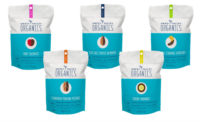New Functional Confectionery Products
By Derek Schmitt
Can Stimulate Category Sales Growth
The candy industry has the
potential to achieve double digit growth over the next several years
despite recent estimates of flat sales over the past 52 weeks (adjusted for
Easter). Yes, double digit, but first, it is important to recognize that
candy dollar sales have been growing at a decreasing rate over the past
several years in spite of the retail price increases driving retail growth.
More concerning is that unit sales of candy items have fallen, while
consumer spending is increasing. A couple of reasons for this lackluster
candy category performance have been America’s focus on obesity and
gas prices shrinking disposable income. So where are these sales going? And
where is the opportunity for candy category growth?
First, consider how the consumer
is changing. Consumers are becoming savvier
about value and nutrition. They are more time-stretched, which has led to
more snacking vs. full meals. This trend has increased the demand for more
convenient, healthier snacking items. It is no
coincidence that nutritional bars hit their
peak growth over the past five years. Nutritional bar manufacturers are
getting better at making their bars taste good, and the definition of
“nutrition” has expanded to include everything from caffeine/energy, to balanced nutrition, to specialized nutritional supplements.
Health and beauty care manufacturers have recognized
the power of candy as a delivery vehicle and have launched chewing gums
that deliver vitamins and minerals, lollipops that contain
sore-throat-soothing ingredients, and mint film products that deliver a
variety of functional ingredients.
These manufacturers are focused on innovative product
development and category creation, while the majority of the candy
manufacturers have relied on brand extensions for growth. Health and beauty
care manufacturers are absorbing some of the valuable impulse merchandising
locations that have traditionally housed candy. Already, some candy
manufacturers have recognized this opportunity and have been developing new
candy formulations relevant to today’s customer.
Research and product development must come first and
fast to provide sugar alternatives and flavor masking. Breakthrough
development of sugar alternative ingredients by companies like Cargill, has
reduced digestive upset and glycemic impact significantly from the more
widely used maltitol. Sucralose has shown tremendous potential as a
substitute for sugar and has been used with fruit juice to allow marketing
of 100% fruit juice candy items. Even fruit-based ingredients are lowering
dependence on sugar. More needs to be done to further the progress on
developing sugar substitutes; new sweetener technology should be
aggressively pursued by candy manufacturers.
First and foremost, candy has to taste good to
succeed. Functional ingredients provide unique challenges. Caffeine, for
example, is very bitter, yet it is the main ingredient in many
“energy” products. New technology to encapsulate these types of
ingredients are showing great promise toward improving taste without
reducing efficacy. Keeping up with FDA requirements can be a challenge, but
is a worthwhile investment.
In Japan and Germany, consumers spend $150 per capita
on functional snacks vs. Americans who spend less than half that, but the
gap is quickly closing. We have been feeding our kids 12 essential vitamins
and minerals in their cereal for years; it is time for the candy industry
to catch up. Now is the time for the candy industry to embrace this more
healthy change in the customer. n
Derek Schmitt, former candy category manager for 7-Eleven, now owns and operates Category
Solutions LLC. Category Solutions is a product development and consulting
company specializing in the functional confections arena. Derek can be
reached at (214) 215-6603 or at derek.schmitt@comcast.net.


